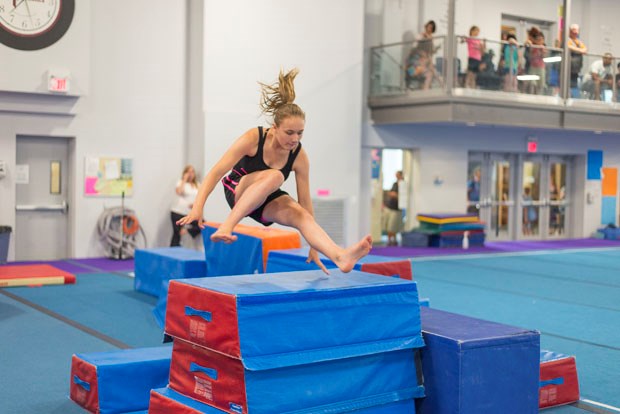There are sports that include running, vaulting, jumping, rolling, climbing and swinging, but only parkour brings them all together in one fluid dance through a technical obstacle course.
Much like rock climbing, skateboarding and martial arts, it's a sport that was once considered "extreme," but is rapidly gaining acceptance in the world of fitness and physical education.
This reality is signalled by the fact the City of Langley recently installed a 10,000-squarefoot parkour course where participants navigate obstacles using gymnastic moves.
"I think it's slowly becoming more accepted in communities now," says Edmonton native Tyler Chassie, 25, who was recently at Delta Gymnastics to run parkour clinics. "It's seen as more of a positive thing now."
Chassie began practising parkour in 2011 outside in the urban environment, which is the birthplace of the sport. Although the activity has roots in military training, parkour didn't become truly popular until videos of the stunts were shared online in the late 1990s and 2000s showing men and women running and jumping across railings, ledges and buildings in various cities around the world.
While videos on YouTube have depicted some fairly extreme stunts, Chassie found success in bringing those stunts indoors under controlled conditions and in an environment where those techniques could be practiced in safety and without the same risk of injury to life and limb.
"Inside it's safe as long as the coaches know how to teach properly," cautions Chassie.
"But only if the equipment is safe or if the coaches know the proper equipment to use for the drills."
Before begnning each parkour class, Chassie will drill his students on the safety rules. And if a student doesn't complete an exercise with a safety roll, he will make them do three rolls on the mats before returning to the drills.
So, just what kind of person gets into a sport like parkour? Looking at a sample of Chassie's class, it's all ages and abilities, sexes, and ethnic backgrounds. There is no particular size, skill or experience level required to begin.
However, Chassie says students who are already into gymnastics generally pick up the sport quickly. As do people who have coordination with running or rock climbing. But really, anybody who engages in some fitness on a regular basis is an ideal candidate, he adds.
"Any sport you have makes for a better parkour athlete," he explains.
YouTube videos may have fed interest in the sport, but clinics like the one held last weekend in Ladner help it to grow and foster demand for regular classes.
"There's a big increase and interest [in parkour]," says Chassie. "In the beginning a lot of people didn't know what parkour was and now everybody knows what it is when they come and they're just excited to start."
It's certainly not just a sport for boys either. Girls do particularly well, according to Chassie's five previous years of coaching experience.
"They come in thinking it's only going to be boys and they just feel like they have to do better than the boys so they get in there and work hard. I think girls are usually more determined than the boys," he adds.
Chassie is currently training coaches at Delta Gymnastics and he's hoping the facility could soon offer the program regularly.



